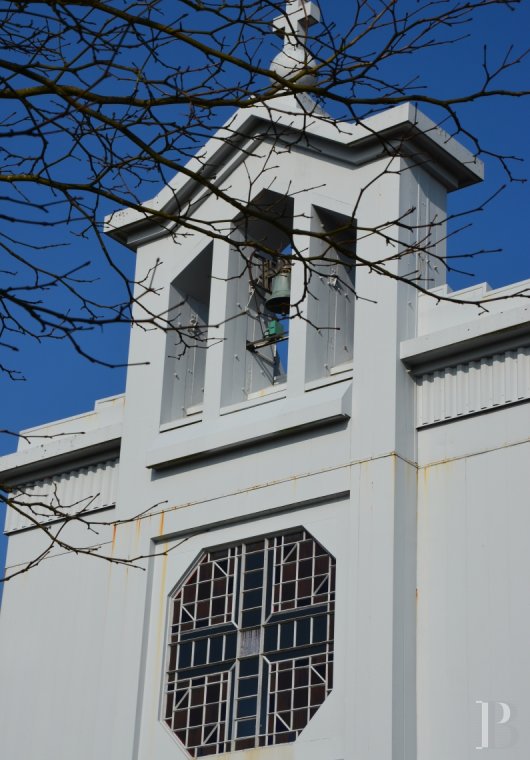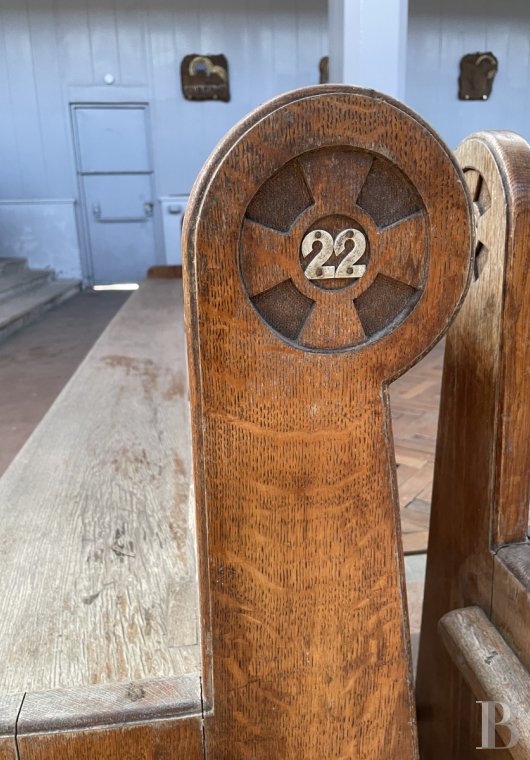Add to favorites
Log in to your personal space

From a forecourt surrounded by plane trees, the unique, metal silhouette of the Sainte-Barbe church (named after the patron saint of miners) stands proud. The church was designed by an architect with a trailblazing genius and commissioned by famous forge masters of the region between the two wars. Time almost got the better of its apparent solidity, as evidenced by the tears of rust that flow along the facades despite a first restoration campaign at the end of the 1990s. But when passion gets involved, anything becomes possible again. The new owners, enchanted by this moving testimony of innovative expertise and by the pure Art Deco architecture, now wish to open the property to multiple cultural projects in order to ensure its sustainability. We have no doubt that creative minds will be able to seize this great opportunity that will make the revival of this former place of worship possible and inscribe it in the history and social fabric of the region forever.
The building was dormant when it was offered to us for sale, we simply could not refuse the opportunity to come to its rescue. The location was less important to us, but it was an opportunity to discover a corner of France whose strength and character came as a real surprise. Our goal was to make it available to those who have always known, built and used it. But we also aimed to enliven the place with cultural events. To do this, we needed to carry out works and then maintain it, meaning we had to find one or two commercial uses for the property as a source of income. Renting this place means participating in the economic and cultural development of a region that really needs it. Not a penny will be diverted from this mission.

It is a unique world of its own! Rectangular in plan with an imposing central nave that stands 11.5 metres high, 30m long and 10m wide, the church is flanked by two lower aisles which form projections on either side which are three quarters of the length of the church. On the forecourt at the front, a well-proportioned bell tower marks the entrance to the building and, at the opposite end, a discreet apse highlights the location of the church choir. Through the rectangular volumes, the design of the windows, and the crowning frieze in "batons" which surrounds the central nave, the whole building showcases typical Art Deco style that corresponds to when it was constructed.
The property's history is recent and linked to its industrial environment. It was built between 1937 and 1939 according to Claude Robbe's design, an architect of the Wendel company in Hayange (owner of the local iron mining company). The construction was carried out by Ferdinand Fillod. In 1922, he started building metal construction huts. He was very quick to put radically new approaches to metal building methods in place. As early as 1928, he perfected a system for prefabricating metal buildings which he patented worldwide. The steel panel (1929), the all-steel house, the inclined walls (1935) and the vertical walls (1950s) then followed. For around twenty years, historians have been rediscovering the importance of this pioneer in the field of prefabrication, fifteen years before Jean Prouvé. The construction was designed as a prototype of a prefabricated church that can be assembled by unskilled labourers and exported around the world to mission countries. Due to the war, this project never came to fruition and the prototype became the property of the constructors who were mostly Polish and Italian. Social, economic, and religious histories find a meeting point here which explains the strong character of the building.
The astonishing experience of seizing a unique architectural monument that has moved away from its initial vocation but with an ever-present spirit and a heart that will never stop beating. A home to share.
Arnaville, a village that was on the German border between 1871 and 1914. The radiant city of Le Corbusier in Biey. The Baccarat Manufacture museum (where the art of crystal making was created in 1764) presents a scenography that showcases the virtuosity of its craftsmen, fifteen of whom are listed amongst the Meilleurs Ouvrier de France. The Embroidery Conservatory of Lunéville. Classified as a UNESCO intangible cultural heritage, beaded and sequined embroidery is an art that was invented in Lunéville in 1870. Meurthe-et-Moselle can be explored by bike along the six hundred kilometres of cycle paths and green or urban routes. The Sacred and Baroque Music Festival of Froville takes place in September. The Château de Cons-la-Grandville. Avec Amour, a restaurant in Terville with an "Ecotable" label, serves creative, gourmet cuisine that is in tune with the seasons and prepared with local products mainly sourced from organic farms or sustainable sectors.

The history, the singularity, and the vast 500m² surface area of the church provide a wide range of possibilities for filming or photo shoots. There is an outdoor car park with 38 spaces available for film crews.
ref 472084


 A link to enter a new password has been sent to you by email.
A link to enter a new password has been sent to you by email.
By continuing your navigation, you accept the use of cookies to offer you services and offers adapted to your centers of interest and to measure the frequentation of our services. Learn more